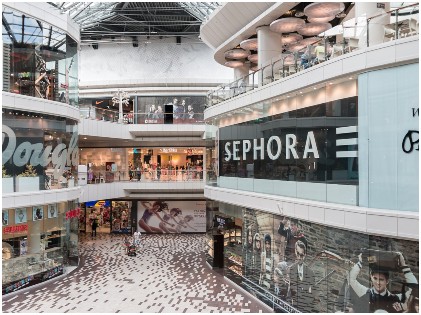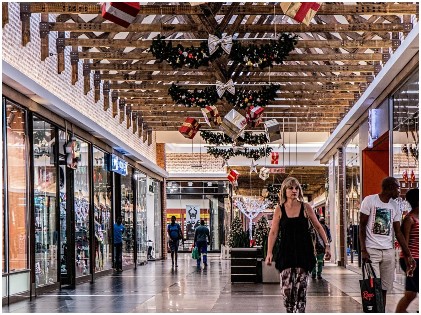Lifestyle centers are a new emerging trend. They are a breath of fresh air and a welcome change from the soulless shopping malls that categorize urban and semi-urban living. You can call them cousins of malls. These centers are in vogue for the retail façade they offer. But unlike shopping centers, their scope does not limit itself just to shopping. In fact, as the name suggests, they have a whole lifestyle experience to offer. It would be apt to call them commercial developments wearing a traditional look from the shopping perspective. Besides shopping, it also has numerous leisure activities for upscale consumers.
Is A Lifestyle Centre An Extended Version Of A Mall?
 The International Council of Shopping Centres (ICSC) defines a lifestyle center as a ‘specialized center’ with ‘upscale national chain specialty stores. It also has dining and entertainment in an outdoor setting. Akin to a leisure-based destination, there are entertainment options aplenty. So you marvel at the ambiance, the design, the amenities like street furniture, fountains, etc. Besides that, it also has numerous dining options perfect for people who are there for ‘casual browsing.’ All this would certainly impart a feeling like that of the mall, but there are differences.
The International Council of Shopping Centres (ICSC) defines a lifestyle center as a ‘specialized center’ with ‘upscale national chain specialty stores. It also has dining and entertainment in an outdoor setting. Akin to a leisure-based destination, there are entertainment options aplenty. So you marvel at the ambiance, the design, the amenities like street furniture, fountains, etc. Besides that, it also has numerous dining options perfect for people who are there for ‘casual browsing.’ All this would certainly impart a feeling like that of the mall, but there are differences.
Malls have several department stores (think of Sears, Macy’s, Lord & Taylor). In contrast, these centers have larger specialty stores like Crate & Barrel, Williams-Sonoma, Pottery Barn, or film theatres. Most malls are large and spread over an area of no less than 800000 square feet in retail units. However, lifestyle centers are somewhat smaller, say, 320000 square feet.
Nowadays, some of the most affluent suburbs throughout the country are witnessing the rise of these centers. And most of them are useful in developing real estates like apartments, flats, condos, restaurants, fine dining outlets, grocery stores, and movie theatres, to name a few. A lifestyle center is a better and profitable venture compared to the singular focus on retail in malls.
More Attention To Detail
 Experts believe that the design and pattern of lifestyle centers are drifting away from ‘elegant’ and ‘sophisticated’ architecture. They are moving towards ‘architecture of comfort.’ Few developers in the US are trading soaring atriums of most malls, only to pay attention to details. This includes cast-iron lighting, sidewalks made with cobblestone Art Deco-inspired neon signs, and more- primarily what a lifestyle center would contain.
Experts believe that the design and pattern of lifestyle centers are drifting away from ‘elegant’ and ‘sophisticated’ architecture. They are moving towards ‘architecture of comfort.’ Few developers in the US are trading soaring atriums of most malls, only to pay attention to details. This includes cast-iron lighting, sidewalks made with cobblestone Art Deco-inspired neon signs, and more- primarily what a lifestyle center would contain.
For example, the Market Common Clarendon in Arlington, Virginia, was completed way back in 2001. The developers emphasize vital details like pavements, facades, signage, plantings, fountains, and sidewalks. But anybody would think that they spent a lot of money in the process for the extras. The developers were quite intelligent in balancing the price tag after they saved many resources by not building the mall’s roof!
Exclusivity Of Lifestyle Centres
It would be wise to say that ‘eclectic’ describes the architecture of lifestyle centers perfectly. Most developers either ask architects to provide their invaluable inputs about a certain architectural era or resort to multiple architects on a single project. With most places choosing to incorporate historical elements in retail projects, lifestyle center designs replicate their evolution.
Also, malls stick to homogeneity in both form and retailing. So with the monotony that these chain stores tend to induce, lifestyle centers are a welcome change that effectively blends the (same) chain stores. Besides that, it also adds a few quirky styles in stores to provide for a more upbeat, unique, and ‘unchain like feel.
Was Gruen’s Vision Fulfilled?

There was a shopping mall pioneer and architect among the Jews from Vienna in the 1950s called Victor Gruen. He had ambitious ideas about lifestyle centers. He mentioned that shopping malls would bring ‘urbanity’ to the otherwise boring look of the suburbs.
Gruen found good prospects in shopping centers. And the belief was that they could serve as ‘communities,’ wherein people would take frequent strolls, gather in groups, and socialize. So the ideal mall would be the one having day-care centers, libraries, jazz concerts, community theatres, art shows, and more.
Victor Gruen’s 1960’s book, the Shopping Towns USA, is instrumental in shaping the way we perceive malls today. It helped most people realize that shopping centers can fill a void only if it brings together other civic, social, and educational facilities.
Well, the next time you visit a mall, that is surely a thought that you are bound to recall.




